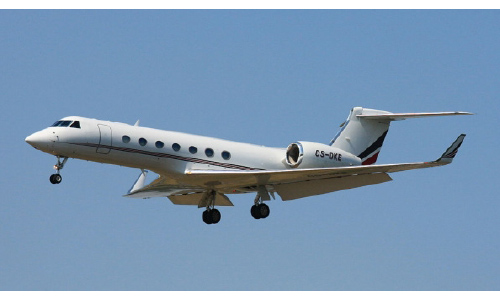 Aircraft Bluebook Marketline | Comments Off |
Aircraft Bluebook Marketline | Comments Off | Situational Awareness
 Wednesday, July 24, 2019 at 7:17PM
Wednesday, July 24, 2019 at 7:17PM From The Weekly of Business Aviation, Aviation Week Intelligence Network / awin.aviationweek.com

Used Bizjets for Sale Up 2% in June
The number of used business jets for sale rose 2% in June to 1,772 aircraft, which represents 7.6% of the active fleet, according to a report by Jefferies.
Inventories of heavy jets rose 3% year-over-year, while medium jet inventories declined 2%.
The number of newer aircraft on the market represents 5.8% of the used fleet, “which may be a relatively low level as we have been hovering at this rate for a year or so,” Jefferies said. “We now expect new deliveries to grow by 8% in 2019 after a modest decline in 2018.”
The inventory levels of used Dassault jets on the market declined 2% in June compared to a year ago, with 57 aircraft for sale. Pricing rose 6%, driven by the Falcon 2000 series.
Gulfstream inventories rose 6% from a year ago with 89 aircraft for sale, up from 84 a year ago. Pricing declined an average of 13% from a year ago.
The number of Cessna business jets for sale rose 13% from a year ago with 213 aircraft for sale, representing 5.9% of the active fleet. Average list prices rose 3% from...
 Aircraft Bluebook Marketline | Comments Off |
Aircraft Bluebook Marketline | Comments Off | Cessna Citation Sovereign 680 - Aircraft Bluebook At-a-Glance
 Wednesday, July 24, 2019 at 6:59PM
Wednesday, July 24, 2019 at 6:59PM By Chris Reynolds, ASA | Editor/Aircraft Appraiser | Aircraft Bluebook

Aircraft Bluebook has reviewed the current market status of the Cessna Citation Sovereign 680 business jet for this At-a-Glance update. Research for this study was obtained in part from Aircraft Bluebook, Aircraft Bluebook’s Historical Value Reference, the FAA’s registry web site and various trade services.
Demand
Produced from 2004 through 2013*, about 98 percent of the Sovereign fleet is currently in service (approximately 345 aircraft) with the vast majority in the U.S. (of which NetJets has been the largest operator). At the time of this writing, approximately 15 - 20 Sovereign 680s, representing a little over four percent of the active fleet, were reported for sale. Average time on market is likely 150 days or longer; equipment, time/condition and...
 Aircraft Bluebook Marketline | Comments Off |
Aircraft Bluebook Marketline | Comments Off | Charter, Fractional, Ownership, Managed: Which Is Right For You?
 Wednesday, May 22, 2019 at 4:20PM
Wednesday, May 22, 2019 at 4:20PM | Business & Commercial Aviation
Today’s market for private aviation offers a dizzying array of choices. What benchmarks do advisors use when guiding customers among them?
In a simple world, the expected number of flight hours for the year would dictate the choice of charter, jet card, fractional or “full” or managed ownership. But there is substantial overlap among the options because of the needs and wants of customers.
So, while acknowledging the flaws of benchmarking choices by flight hours, here are overlapping ranges:
0-25 Hr. Trip-by-Trip Charter
25-100 Hr. Jet Card
25-250 Hr. Fractional
150-400 Hr. Ownership
Trip-by-Trip Charter: Do you only use private aircraft occasionally? Do you know what you need/want for aircraft size and capability? Charter companies were the original charter brokers. They forged relationships with the local businesses that used charter, and they built informal networks to cover the need for substitutes and larger aircraft — i.e. “You need a Gulfstream for the next trip? Don’t worry. I know a guy.”
As the industry grew, charter companies hired people whose sole job was to build these customer and charter network relationships. And then those people began to leave (with their lists) and become brokers.
So, if you want to book trip-by-trip charter, build a relationship with a charter company or a broker. And as your usage increases, they will tell you about jet cards.
Jet Card: What is it? Jet cards grew out of an older business model called “block charter.” Commit to buying 50 flight hours from your local charter company and receive a nice discount. Today, there are hundreds of choices. In fact, the only common denominator is a discount for a block charter commitment.
Many, if not most, of the offerings are made by brokers, not charter companies themselves. Don’t be fooled by a low hourly rate: The devil is in the details, and the details are a maze of fuel surcharges, daily flight minimums, service area limitations and dozens of other factors.
Before deciding on a jet card, decide what matters most. Long-time readers of Cause & Circumstance don’t view operator safety as a given. Yet some customers assume that any and all operators are safe, and, therefore, why not seek out the lowest price? Price should never be the sole factor in any aviation decision.
Is there a real company that you will be trusting with your funds and your safety? What is its criteria for selecting operators? Talk to other customers before committing.
Fractional: Fractional aircraft ownership programs officially date back to the inception of NetJets in 1987. That is when the N-numbers ending in QS began. Now ubiquitous on FBO ramps, “QS” stands for “quarter-share.”
Although FAR Part 91, Subpart K was created just for fractional ownership operations, today many of the flights are operated under Part 135, either because the customer bought or leased less than the minimum interest required for fractional operations, or simply because the customer elected not to share operational control with the program manager.
Fractional programs helped spawn the growth of jet cards with the Marquis Jet Card, which allowed customers to purchase 25 flight hours in the NetJets program. Today, fractional and at least some jet cards are very similar. Do you sometimes need two jets on the same day? No problem. Heavy jet today, light jet tomorrow? Sure. Because of the flexibility of fractional, some companies buy more than 400 hr. a year, even though they could easily justify “whole” aircraft ownership.
Management Company: There is a step between owning a fractional aircraft share and having your very own flight department. Own your own aircraft, but have it managed by a charter/management company.
You can have the aircraft managed by a charter company, and still have your trusted crew. And the aircraft can be chartered to others when you are not using it if you want to offset overhead. Most companies give you the choice of being the direct (W-2) employer of the crew, or the management company will manage payroll and benefits.
However, if your W-2 crew is to fly for the charter company under Part 135, then those pilots will need to sign “agency agreements” to acknowledge that they are under the operational control of the charter company on Part 135 flights.
But how do you choose a management company? Price should not be the first criteria. Talk to other owners that use the company. Typically, the choice is between a large national operation, such as Executive Jet Management, sister company to NetJets, or a local charter company. Many owners prefer the local touch and having a private facility at their home base. Jet Linx is a national company that provides numerous local bases, so that the aircraft owners can have the private facility experience at each base.
To charter, or not to charter: Done right, chartering out your aircraft when you are not using it offsets your cost of ownership. Done wrong, additional maintenance costs eat up the income, and wear and tear reduces the resale value of the aircraft. Where is the happy medium? There isn’t a simple hour benchmark answer.
You will need spreadsheets and specific operating costs to find the balance that works for you. On the plus side, the charter market today is ravenous for additional aircraft. If you want charter hours for your aircraft, you will get them.
Ownership: For those who need, or can simply afford to own an aircraft and employ their own flight department, the satisfaction that comes with trusted people and custom, trusted equipment is still the ultimate in private aviation. There are a number of flight departments today that operate less than 200 flight hours per year. Conventional wisdom would dictate that these users would be better served by fractional ownership or charter. The owners know that. They just don’t care.
 Aircraft Bluebook Marketline | Comments Off |
Aircraft Bluebook Marketline | Comments Off | Luckily For Bizjet-makers, China Is Not Asia’s Only Market
 Friday, May 10, 2019 at 10:23AM
Friday, May 10, 2019 at 10:23AM | Aviation Week & Space Technology
It is a case of Southeast Asia to the rescue. As demand for business jets slumped last year in China, the countries to the south stepped up. The overall Asia-Pacific fleet has barely grown, though trade in secondhand aircraft looks brisk. Notably, quite a few business jets have left China.
The Chinese industry can at least look forward to the easing of its worst operational restriction next year, with the opening of a ground facility at the new airport at Daxing by state-owned Capital Jet.
Southeast Asian countries collectively added a net 14 aircraft to their fleets in 2018, a 6% increase, according to a comprehensive annual report compiled by Hong Kong consultancy Asian Sky Group. Mainland China, Hong Kong, Macau and Taiwan—counted together as Greater China—stagnated. Far from soaking up ever larger numbers of personal aircraft, as manufacturers once expected, Greater China’s fleet shrank by...
 Aircraft Bluebook Marketline | Comments Off |
Aircraft Bluebook Marketline | Comments Off | Piper Meridian: Cheapest High-Performance Single-Engine Turboprop
 Thursday, May 2, 2019 at 9:42AM
Thursday, May 2, 2019 at 9:42AM 
| Business & Commercial Aviation
Piper’s PA-46-500TP Meridian, rebadged as M500 in 2015, made its debut in September 2000 as a 2001 model. It has been the lowest-priced pressurized, single-engine turboprop offered by an airframe manufacturer for nearly two decades. Piper created the Meridian by modifying a Malibu Mirage to handle and additional 500+ lb. of weight and higher cruise speeds and then replacing its 350-hp piston engine with a 500-shp Pratt & Whitney Canada PT6A turboprop. Meridian most assuredly was a design-to-cost development program as reflected in the final product.
The Malibu, launched almost three decades ago, was the product of Jim Griswold, head of Piper engineering in the early 1980s. The aircraft was a near-perfect, clean-sheet, pressurized cabin-class piston single, one with clean aerodynamics, a high aspect-ratio wing and low empty weight. It was the first single to offer cabin-class twin comfort and speed with much lower operating costs. But Malibu’s turbocharged Continental engine and succeeding Mirage’s boosted Lycoming piston engine both failed to...
 Aircraft Bluebook Marketline | Comments Off |
Aircraft Bluebook Marketline | Comments Off |  Single-Engine Turboprop in
Single-Engine Turboprop in  BCA
BCA 







